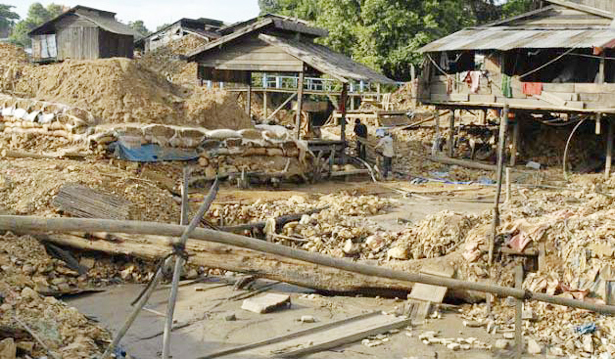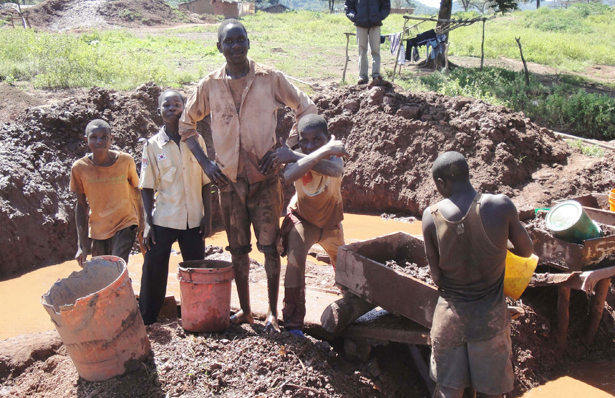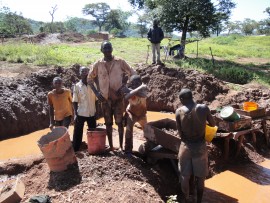Source #7
Artisanal Gold Mining
Description
Artisanal gold mining refers to small-scale informal mining activities that mine ores containing gold and process them to recover the gold. While the sites are often individually small-scale, 20 percent of the world’s gold is produced in artisanal gold mines and it releases more mercury than any other sector worldwide.55 The technologies and methods are exceedingly low-tech and the ore is usually processed in rudimentary structures with no pollution controls. The ore is crushed and washed to recover the gold, with mercury being added during the process. The mercury binds to the gold to form a dense lump of amalgam that is easy to recover from the crushed material. The amalgam is later heated, often with blowtorches or over open flames, so that the mercury evaporates and gold sponge is left. Gold sponge is then processed in gold shops, where more mercury is evaporated from the gold sponge and pure gold is left. The process is done by hand with very little or no mechanized tools. Artisanal mercury based gold processing is very inefficient; mercury use ranges from 4-20 parts of mercury per part of gold recovered and the process captures only about 30% of the available gold.[1] Despite the inefficiency, mercury is used because it is cheap and readily available. Because of the informal nature of the industry, there is little knowledge about best practice, putting the community at risk during and after the processing is complete. Non-industrial or individual purchase and use of mercury is illegal in most countries, however imports are routinely averted and sold on informal markets.[2] Once the gold ore has been worked out, the mining sites are usually abandoned, with no formal clean up or containment of waste. Worldwide there are thousands of abandoned small-scale mining sites, many with a legacy of mercury pollution and widespread health impacts.[3]

Artisanal gold mining is a small-scale industry but contributes a large number of polluted sites to the Blacksmith Institute’s database. There are over 200 sites that potentially expose more than 4.2 million people to the risk of toxic pollutants. The majority of artisanal gold mining sites in the database are in Africa and Southeast Asia, however there is a high concentration of artisanal miners in Latin America as well. It is estimated that artisanal gold mining is done in as many as 55 countries employing between 10 and 15 million miners.[4] Artisanal gold mining is a subsistence industry engaged in at the individual level, and is likely to be located in countries or regions with limited government oversight or regulation of small-scale industrial activities. Small gold mining operations can be started with very little investment or infrastructure and producers can often make 70 percent or more of the price of international gold, a rare economic advantage in small-scale or informal industries.[5] Gold is an easily traded commodity and prices are continually stable or growing, making it a very attractive subsistence industry for marginalized members of society.
Exposure Pathways
The US EPA estimates that approximately 400 metric tons of mercury is released into the air each year from the processing of gold in artisanal gold mining.[6] Mercury is released during the heating of amalgam, when mercury is evaporated. The mercury vapor is inhaled directly by workers and is absorbed into surrounding surfaces, where it is re-emitted into the air over time. The mercury vapor is also released into the environment and settles on plants, soil and waterways nearby. Gold processing is often undertaken in residential areas and done in the open around children and other family members, directly exposing the community to the mercury vapor. Those not directly exposed to the fumes are at risk of ingesting mercury that has been absorbed by waterways, soil or fish. The largest majority of exposures in the Blacksmith Institute’s database are through inhalation of contaminated dust or vapors and ingestion of contaminated water.
Top Pollutant(s)
Mercury is the top pollutant in artisanal gold mining operations. In the Blacksmith Institute’s database it puts close to 3.4 million people at risk for exposure. Mercury is a bio-accumulative toxin that is absorbed by fish, birds and other wildlife, contaminating local food chains. It is known to cause neurological damage, especially in fetuses and children. As prevalent and hazardous as mercury is in small-scale mining, other pollutants are also released. Within the database lead has been found at over 20 sites, putting close to 250,000 people at risk. Lead is often released when the lead-containing ore is roughly crushed. Lead also causes neurological and developmental damage in children.

Global Burden of Disease
Blacksmith Institute estimates that lead from artisanal gold mine sites contributes roughly 1 million DALYs to the total burden of disease in the 49 countries assessed. However, the DALY number presented for this industry is by far the largest under-calculation presented in the report. There is very limited data available to calculate DALYs from mercury exposure, the key pollutant in artisanal gold mining. While the DALYs here are significant, in reality they are almost certainly an order of magnitude larger than the number that can currently be calculated.
What is being done?
In the last decade, the harmful effects of mercury poisoning from artisanal gold mining have been recognized and many international organizations are working to provide training, technology and safety standards for the industry. The EPA and the Argonne National Laboratory (ANL) have partnered to design a technology called the Gold Shop Mercury Capture System (MCS), a simple technology that captures and treats mercury emissions and can reduce emissions by 80 percent.[7] There are examples like this being implemented all over the world. Education can change behavior and is the best approach to altering dangerous practices, as there are many alternative approaches to gold processing that are less harmful to human health. Ideally all small-scale miners would be converted to mercury-free mining methods, but this is a major ongoing challenge.
Even though mercury use is pervasive among gold miners and processors, awareness of potential hazards to community health and the environment is very low. The US EPA, UNEP, and Global Mercury Partnership supported Blacksmith, in collaboration with the Ministry of Environment and Yayasan Tambuhak Sinta in Indonesia, in the implementation of interventions that reduce mercury emissions and improve mining practices. The project provided retorts to miners that are easy to use and inexpensive, in order to re-capture mercury that is emitted during the burning process. The mercury can then be reused multiple times, greatly reducing environmental damage. Additionally, Blacksmith installed dozens of water-box condensers in gold shops that capture additional mercury during the refining process. This has led to a dramatic reduction in the level of mercury emissions at these sites.
Footnotes:
[1] “Reducing Mercury Pollution from Artisanal and Small-Scale Gold Mining.” U.S Environmental Protection Agency. Washington DC. 2012 Available at: http://www.epa.gov/oia/toxics/mercury/asgm.html
[2] Ibid.
[3] Veiga, M.M. et al. “Abandoned artisanal gold mines in the Brazilian Amazon: A legacy of mercury pollution.” Natural Resources Forum 26 (2002) 15–26
[4] Ibid.
[5] Veiga, M.M., Baker, R. “Protocols for Environmental and Health Assessment of Mercury Released by Artisanal and Small Scale Miners”. Report to the Global Mercury Project: Removal of Barriers to Introduction of Cleaner Artisanal Gold Mining and Extraction Technologies. 2004.
[6] “A Practical Guide: Reducing Mercury Use in Artisanal and Small-Scale Gold Mining.” United Nations Environment Programme. 2012. Available at: http://www.unep.org/hazardoussubstances/Portals/9/Mercury/Documents/ASGM/Techdoc/UNEP%20Tech%20Doc%20APRIL%202012_120608b_web.pdf
[7] Ibid.

-
Source #1
Battery Recycling
-
Source #2
Lead Smelting
-
Source #3
Mining and Ore Processing
-
Source #4
Tanneries
-
Source #5
Industrial/Municipal Dumpsites
-
Source #6
Industrial Estates
-
Source #7
Artisanal Gold Mining
-
Source #8
Product Manufacturing
-
Source #9
Chemical Manufacturing
-
Source #10
Dye Industry
-
The Remaining Five Sources



